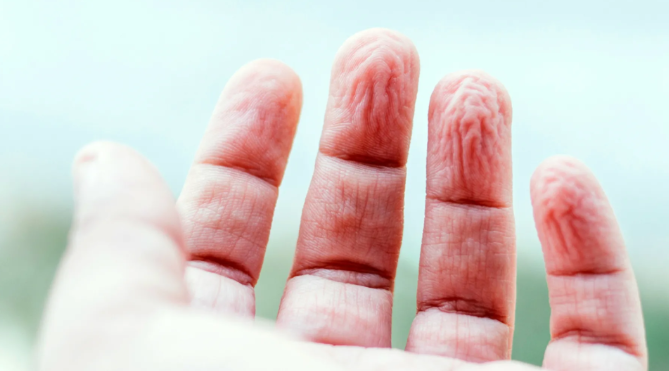Why Do Fingers Wrinkle in Water? A Neurovascular Reflex with Evolutionary Purpose
NEUROSCIENCEALL BLOGS


One of the most overlooked physiological phenomena is the wrinkling of the skin on our fingertips and toes after prolonged exposure to water. Though once assumed to be a passive, osmosis-driven process, recent research has revealed that this reaction is an active neurovascular reflex, a process with both clinical and evolutionary implications.
The Mechanism: Autonomic Nervous System at Work
Contrary to popular belief, finger wrinkling is not caused by the skin simply absorbing water. Instead, the effect is mediated by the autonomic nervous system, specifically through sympathetic vasoconstriction.
When skin is immersed in water, sensory receptors send signals through the sympathetic nerves, prompting blood vessels in the digital pulp to constrict. This vasoconstriction reduces the volume beneath the skin’s surface, causing it to pucker and form the characteristic wrinkles. Notably, this reaction does not occur in individuals with peripheral nerve damage, such as from diabetes or sympathetic denervation, making it a potential diagnostic indicator of autonomic dysfunction.
Evolutionary Significance: Improved Grip in Wet Conditions
A study published in Biology Letters (Wet wrinkles improve handling of wet objects, 2013) proposed that this wrinkling phenomenon serves an evolutionary advantage. The wrinkles function similarly to tire treads, improving grip on wet, slippery surfaces. Participants in the study performed better at grasping wet objects with wrinkled fingers than with dry ones, supporting the hypothesis that this adaptation evolved for survival in aquatic or rain-prone environments, aiding in foraging, climbing, or handling tools.
Clinical Implications: More Than a Curiosity
This reaction is now considered a non-invasive test of sympathetic nerve function. In clinical neurology, delayed or absent finger wrinkling may suggest peripheral neuropathy or sympathetic failure. It offers a simple, cost-effective screening tool, particularly in low-resource settings.
In fact, the “wrinkling test” has been used in pediatric neurology to evaluate nerve function in children with suspected congenital or traumatic nerve damage.
Try It Yourself: A Simple Observation with Clinical Relevance
To witness the reflex:
Submerge your hand in warm water (~40°C) for 10–15 minutes.
Observe the skin on the fingertips; if it wrinkles, your sympathetic function is intact.
Try this on both hands; asymmetric results may indicate localized nerve dysfunction. Of course, this is not a substitute for clinical evaluation, but it highlights how even basic observations can reflect complex physiology.
Final Thoughts
What appears to be a trivial observation, pruney fingers, is a window into the interplay between neurobiology, vascular physiology, and evolutionary medicine. As future clinicians and biomedical researchers, it’s critical to recognize how everyday phenomena may inform diagnosis, patient care, and scientific inquiry. Sometimes, the smallest questions open the door to the deepest insights.